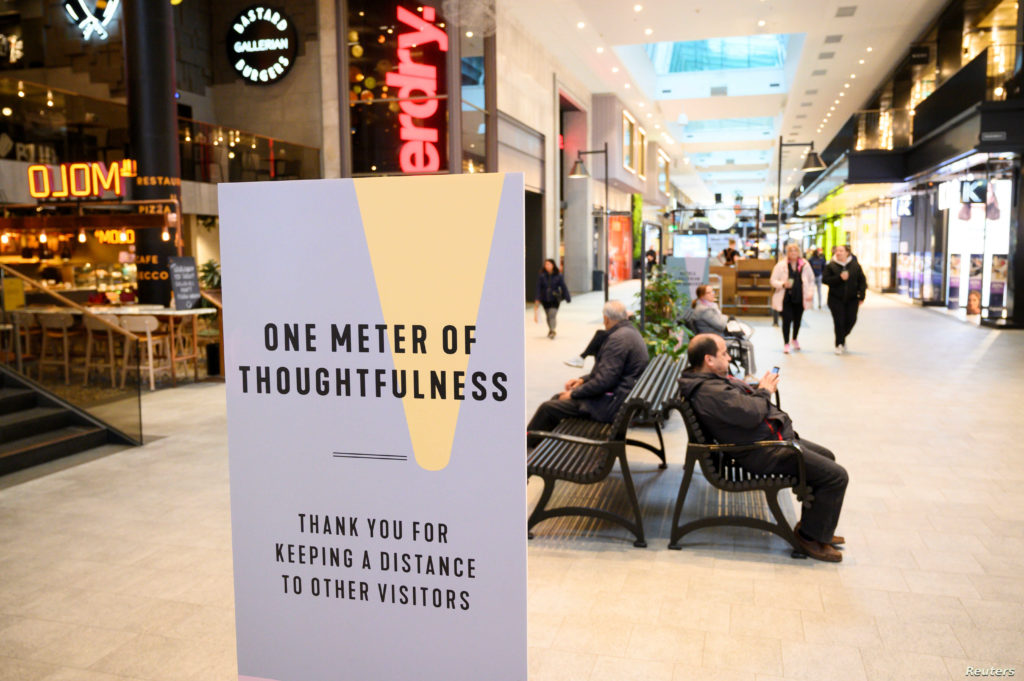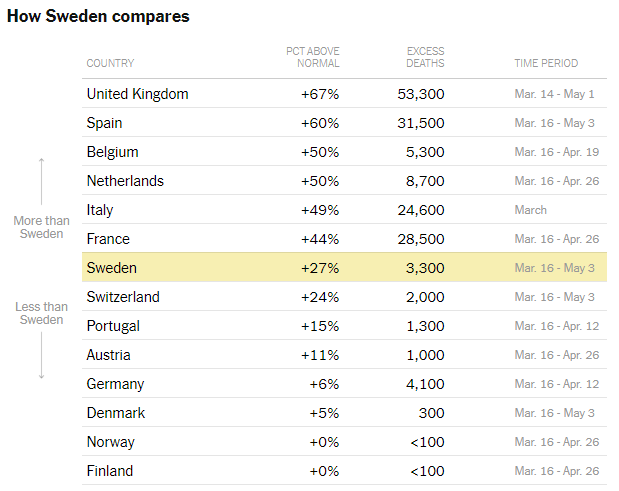Sweden’s COVID Response: So Far, Not Good
Vastly more people died than needed to and the economy still crashed.

While some were faster to do it than others, just about every advanced country on the planet ordered massive business shutdowns and some form of sheltering-in-place to stem the tide of the novel coronavirus. A major exception was Sweden, which took a much “softer” approach for a variety of cultural reasons.
At first, it looked as though this approach may have been prudent. The death rate was lower than in many other European countries and the social and economic impact looked smaller. Many American conservatives touted the Swedish model as one we should be following here.
It turns out, though, that the early perceptions were fueled by wishful thinking. A New York Times report from over the weekend by Lauren Leatherby and Allison McCann points out that,
[W]hile Sweden has avoided the devastating tolls of outbreaks in Italy, Spain and Britain, it also has seen an extraordinary increase in deaths, mortality data show.
In Stockholm, where the virus spread through migrant communities, more than twice the usual number of people died last month. That increase far surpasses the rise in deaths in American cities like Boston and Chicago, and approaches the increase seen in Paris.
Across Sweden, almost 30 percent more people died during the epidemic than is normal during this time of year, an increase similar to that of the United States and far higher than the small increases seen in its neighboring countries. While Sweden is the largest country in Scandinavia, all have strong public health care systems and low health inequality across the population.
“It’s not a very flattering comparison for Sweden, which has such a great public health system,” said Andrew Noymer, a demographer at the University of California at Irvine. “There’s no reason Sweden should be doing worse than Norway, Denmark and Finland.”
The graphic representation is rather stark:

Sweden had 27% more excess deaths year-over-year. The other Nordic countries, the best apples-to-apples comparison, had essentially none.
Still, one could argue that the results aren’t catastrophic.
Two months later, it has not been the worst-case scenario many envisioned. Covid-19 deaths have disproportionately hit the elderly and those in nursing homes, as is the case in most countries, but hospitals have not been overwhelmed. As with the rest of the world, it will be months, or even years, before the full picture of mortality emerges.
“It is clear that mortality in Stockholm has been a lot higher than you would expect from a normal year,” said Martin Kolk, a demographer at Stockholm University. “But we will have to wait and see what happens. It’s a very big difference if we continue to see excess mortality for six more months, or if it will be back to normal levels in a few weeks.”
And officials there make a point that I’ve started harping on of late: the nature of inertia:
“Once you get into a lockdown, it’s difficult to get out of it,” Sweden’s state epidemiologist, Anders Tegnell, said. “How do you reopen? When?”
That’s not to say lockdowns were the wrong strategy; I tend to think they were right. But they do flip the political presumption: staying at home is the new norm and leaders will be blamed for starting back too soon.
Instead of imposing strict lockdowns, public health officials said that Swedes could be relied on to go out less and follow sanitation guidelines.
That proved to be true: As a whole, Swedes visited restaurants, retail shops and other recreation spots almost as little as residents of neighboring countries, according to Google mobility figures.
This is something that I was emphasizing to Facebook friends a month or more ago: even if the Swedish model proved right for Sweden, it’s not necessarily transferable here. Sweden in a true nation-state and its citizens see all other Swedes as part of their tribe, for lack of a better word. That’s just not true in the United States, which has always been multi-national and divided.
But, to the extent the strategy was going to “work” in Sweden was if Swedes simply did what they were supposed to as good citizens rather than because they were forced by government order. Obviously, the former is morally and socially preferable.
But, of course, voluntary compliance has the seem impact as reluctant compliance, in both public health and economic terms. Which is to say, bars, restaurants, and other service industry businesses relying on people to pack themselves into small spaces were going to suffer.
Preliminary evidence shows Sweden has suffered similar economic effects as its neighbors: The Swedish Central Bank projects the country’s G.D.P. will contract by 7 to 10 percent this year, an estimate on par with the rest of Europe. (The European Commission projects the E.U. economy will contract by 7.5 percent.)
The Swedes aren’t known as a reckless people and their government is widely considered competent. Presumably, they made the decisions they did based on their best understanding of the medical advice and the local culture. But, in the short term, it seems that they’ve gotten considerably more people killed than would have otherwise been the case* and not saved the economy.
But even that’s not absolutely certain. First, Sweden hasn’t exactly been the Wild Wild West some American conservatives have touted:
Swedish Prime Minister Stefan Lofven defended his country’s strategy in fighting the spread of COVID-19, pushing back on the notion Sweden has taken a “business as usual” attitude toward the pandemic.
Speaking to foreign correspondents Friday in the capital, Stockholm, Lofven insisted life is not carrying on as normal in Sweden, as he said its international reputation would suggest.
Other European nations have expressed concern about Sweden’s relatively “soft approach” to fighting the coronavirus. While they did ban large gatherings, restaurants and schools for younger children have stayed open. The government has urged social distancing, and Swedes have largely complied.
Further, it’s possible that the higher death count is a factor of something other than the softer lockdown:
Lofven said many people have been staying home, which he says has had a positive effect. He did acknowledge Sweden’s 3,500 deaths, which was far higher, per capita, than its Scandanavian neighbors Finland, Norway and Denmark, all which took a stricter approach.
Lovgren said most of Sweden’s casualties were among the elderly, which, he says had little to do with people “walking around” the streets.
He said Sweden, like several other countries, did not manage to protect the most vulnerable people, including the elderly, despite best intentions.
Swedish media in recent weeks have reported cases where retirement homes have seen a large death toll, with staff continuing to work despite a lack of protective gear or despite exhibiting symptoms and potentially infecting residents.Some retirement homes also have seen a shortage of staff because employees either have refused to work or have been encouraged to stay home even with mild symptoms.
To be clear: a mass of deaths of elderly people in retirement homes from a painful illness—compounded by their loved ones not even being allowed to be with them—is a tragedy. But it may be due to issues only tangentially related to the lockdown.
As Josh Marshall points out, there are so many variables at work that it’s really hard to know for sure.
One thing we can draw from this is that we shouldn’t assume more certainty than is warranted about the effects of different mitigation policies and approaches. Chance and luck play a significant role, at least at first. Culture and demography play important roles in sometimes unpredictable ways. Across the world spread within households has been a major driver of the epidemic. A high percentage of Swedes live alone.
But the biggest takeaway is that we shouldn’t assume that government mandates – either imposing or releasing strictures – are the sole or even largest determinant of social activity or outbreaks. Nor is all skirting of social distancing and civic responsibility done by loudmouths with assault weapons. Even after an area reopens social and economic activity may remain dramatically constrained. Indeed, there’s some preliminary evidence that over the last month social mobility – as measured by anonymized cellphone data – has been increasing in lockdown states while the change hasn’t been as dramatic as some have expected in states that are pushing hard to ‘reopen’.
|
There’s no doubt about that.
As I’ve noted in previous discussions of the topic, I’ve thus far been impacted less than most Americans. I have a job that I can do remotely, indefinitely if need be, and an employer that’s amenable to letting me. Aside from dining out and going to the movies less frequently than we would be otherwise—and even that mitigated by the ability to get takeout and a rather nice home theater setup—I’m living a reasonably normal life.
Most of Virginia started slowly opening for business this past Friday but Northern Virginia remains restricted another two weeks. But I can’t imagine myself going to restaurants or theaters any time soon.






I think you and Josh Marshall both make the case for why planning a reopening strategy is difficult and time consuming and that a lot of planning and prep work needs to be done, both for the initial moves as well as the tracking and tracing that needs to be out there after. And it’s not just case tracing, as I’m pretty sure we need to be doing random testing because the lead time is so long. And the economy may very well get even more borked if it is done shoddily and cases explode. So – Planning. Executing. Monitoring —> Cycle back to modify the Planning. Continuously iterate the cycles.
The Trumpers want to portray this as people who lack courage and are afraid of their shadows vs. courageous heroes willing to do what needs to be done. The reality though is that Trumpers are basically Leroy Jenkins.
Think the way to look at it is that Sweden has lockdown lite. The advantage that conservatives claimed was that Sweden would better preserve economic activity. However, it looks like Sweden will have pretty much the same negative economic effects. Plus they have more deaths. So far it looks like a losing proposition. That said, their approach was accepted much better by their population. They will probably, just guessing here, be able to maintain their lockdown lite much longer than we can maintain our mandatory lockdowns. They probably wont have bozos waving guns around in their capital. Will be interesting to see the long term effects of the different approaches, but in the short term the Swedish approach is inferior.
Steve
I doubt that they have bozos waving guns around in their capital under any circumstances…
A bunch of California is loosening, but it’s the bunch with no actual human inhabitants. LA, SF, SD, SJ all still tight.
If we actually get a workable vaccine it will suppress economic activity which may, by then, have expanded. I mean, tell me I have to suck it up and accept risk because there’s no alternative? That’s tough enough to swallow, but eventually I will. Tell me I need to accept risk when 100% immunity will be available in eight months? Um, no. The last poor bastard to get polio before the Salk vaccine came out? The guy who gets shot two weeks before the war ends?
I like to think of myself as rational and *not* a conspiracy theory believer, but I’ve read enough medical history books and seen for myself the incompetence of our current bunch in charge, and I’ve begun asking myself if I would be first in line for a vaccine. I’m 100% pro-vax in childhood, and get my flu shot. But this? I just don’t find myself feeling trusting.
I have friends in Sundsvall, Sweden, and due to their daughter being in NYC, they’ve been locked down completely for 8 weeks. All of them are safe and without Covid. At least a dozen people they know have caught it, and 3 have died.
Meanwhile, Norway and Denmark have 1/10 the fatality rate of Sweden. https://www.nytimes.com/interactive/2020/05/15/world/europe/sweden-coronavirus-deaths.html
@Dutchgirl: Well, that’s wise. These things can go wrong lots of ways. A quick google-search showed that a contaminated Salk vaccine in Australia sickened thousands in 1961. And at least 1200 cases of polio were caused by a ‘bad batch’ in Bostin in 1956.
It would take Kurt Vonnegut to write the book describing enduring the Trump Administration and the lockdown just to die from the Covid-19 from the vaccine.
So it goes, he’d say
@Dutchgirl: 100% in agreement. I’m waiting until the Canadians say “go ahead”.
@steve:
Anecdotal evidence shows that European countries generally accepted whatever lock down the government imposed. Yes there were exceptions on the margins, but generally folks stayed home. And no, nobody was waving guns.
My mom in the Netherlands is going stir crazy and is super bored. And with the time difference, it’s not easy for us to connect in real time. She reports there is very good adherence in her area, but in some of the larger cities some people are doing whatever, but no guns. There is still a lot of power of social shaming there, so that has got to help. The Netherlands has gotten clobbered, and won’t be normal again. What emerges will have to be different. I was supposed to go visit 2 years running, and I won’t get to go this year either.
Sweden has, measured in deaths per million, a worse death rate than the United States. And if not for the murderous incompetents running New York (Over a third of all U.S. cases and half the deaths are in NY and four contiguous states), Sweden’s death rate per million would likely be twice as bad as the U.S.
For profitable reflexion, Financial Times article Sweden’s death toll unnerves its Nordic neighbours | Free to read
Denmark, Finland and Norway look at maintaining travel restrictions even as they prepare to open up to others (“https://www.ft.com/content/46733256-5a84-4429-89e0-8cce9d4095e4)